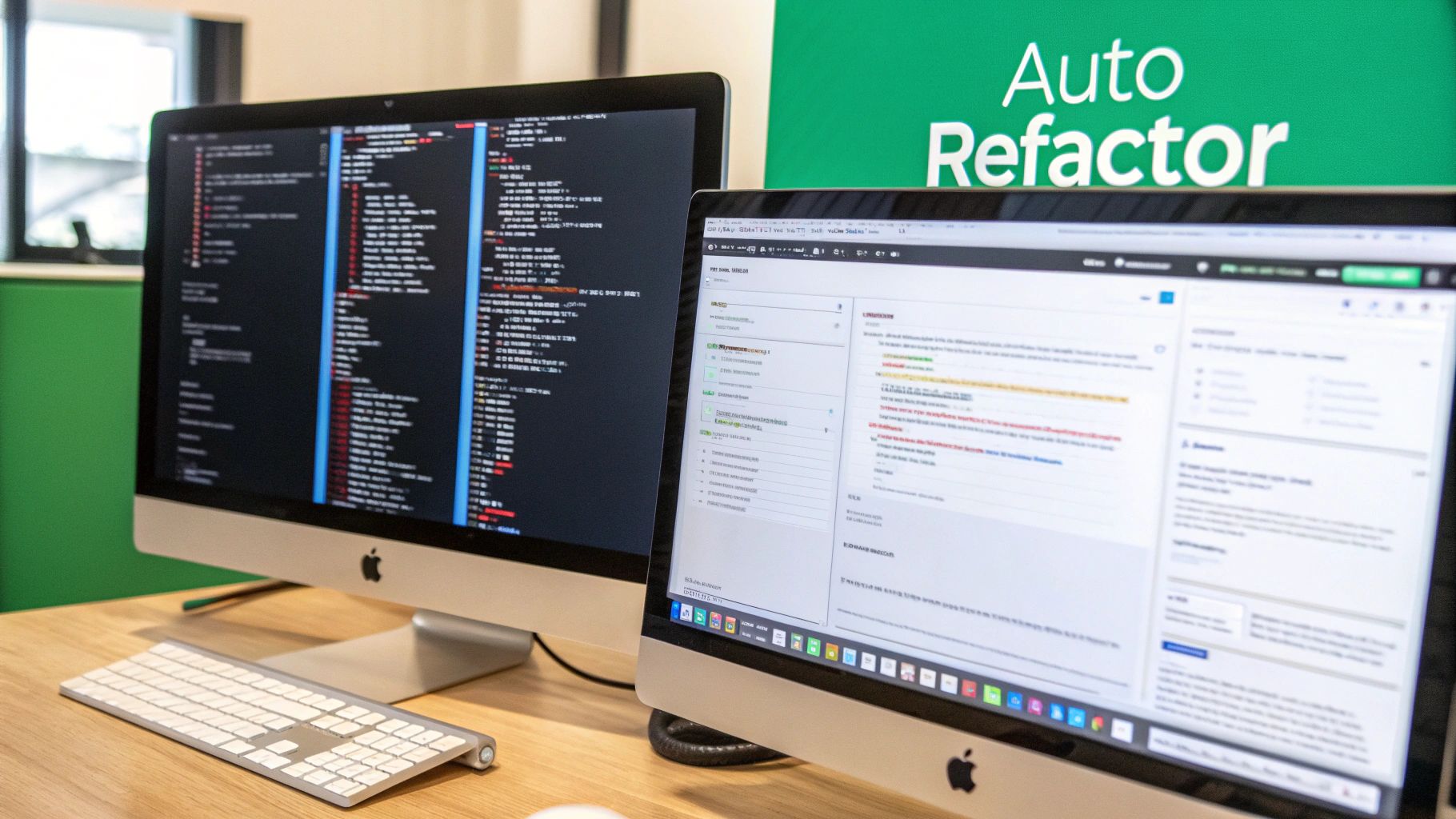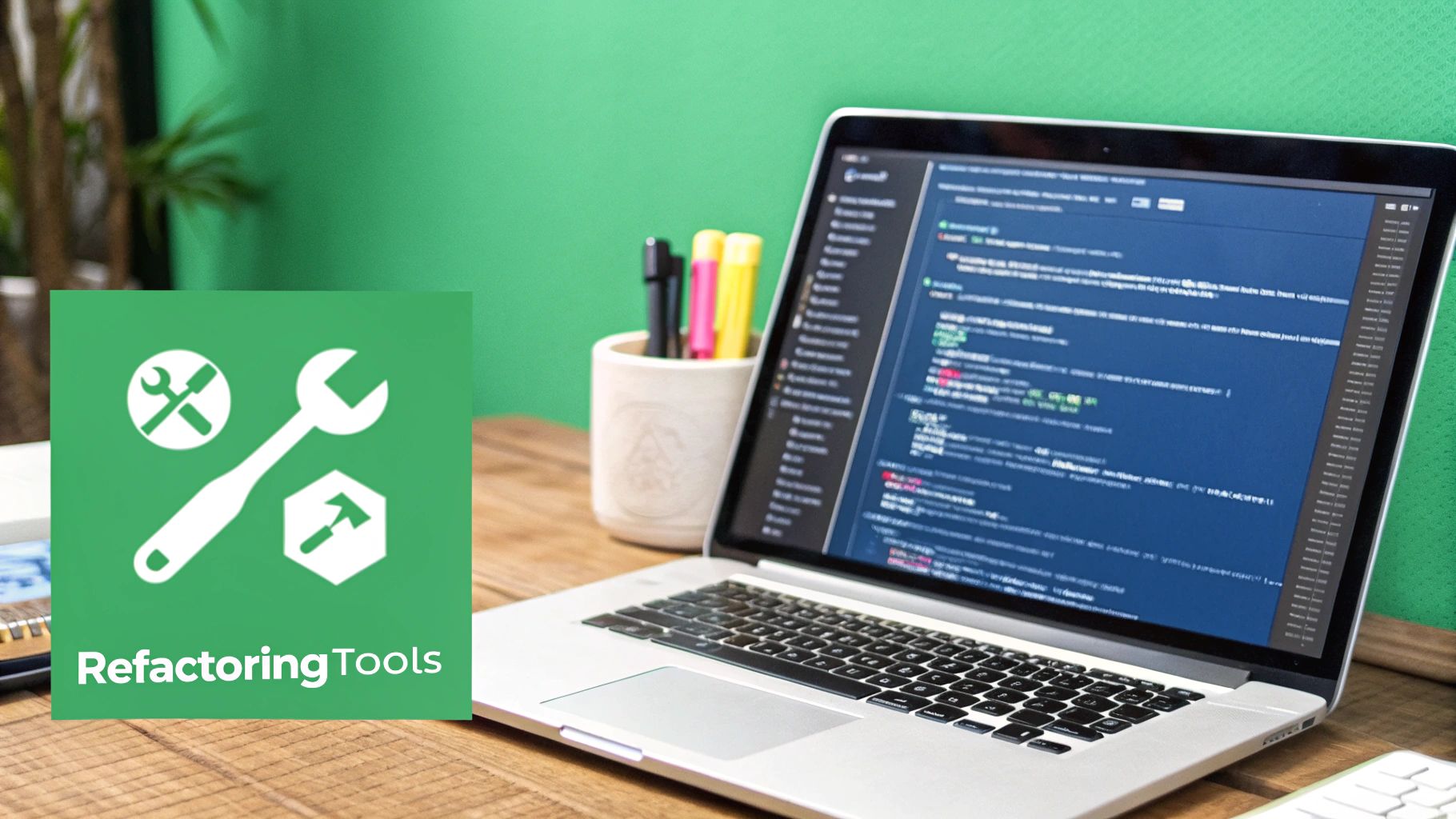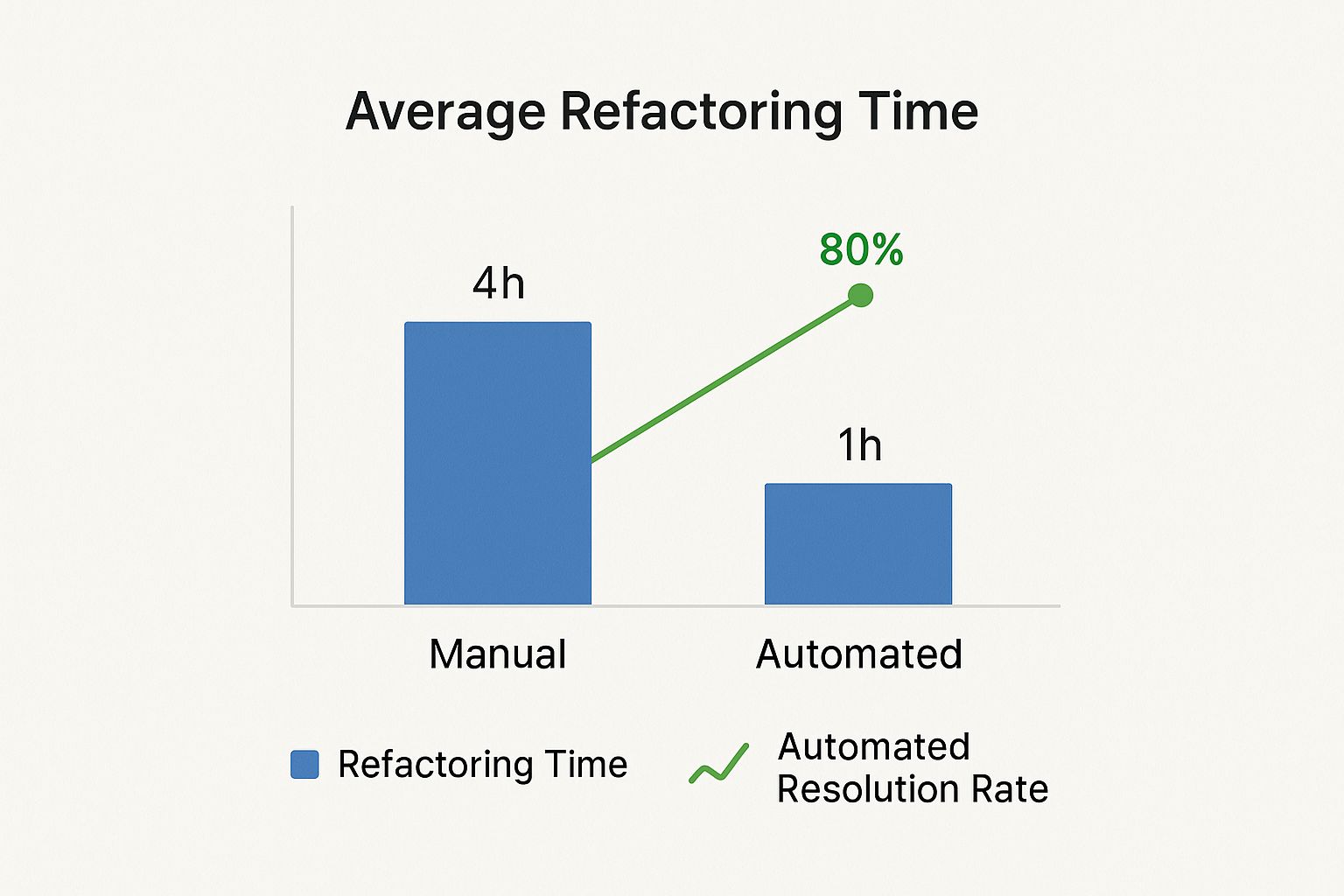Learn how automated code refactoring can streamline your development process, improve code quality, and save time. Discover expert tips today!

Automated code refactoring is changing how development teams maintain and enhance their software. It moves beyond simple find-and-replace, offering advanced transformations that understand the code’s context and purpose. This represents a major improvement over manual refactoring, which can be slow and error-prone. This allows teams to tackle technical debt more effectively and boost code quality without slowing down development. You might be interested in: What is Code Refactoring?
Manual refactoring requires developers to find areas for improvement and change the code themselves. This can be tedious, especially with large codebases.
For example, renaming a variable used in multiple files requires careful tracking and updating of every instance. Plus, manual refactoring risks introducing bugs if changes aren’t consistent.
Automated refactoring tools automate these tedious tasks, minimizing human error and freeing developers to focus on more important work.
Many development teams now view automated refactoring tools as essential. These tools help them maintain code quality at scale, even as projects become more complex. This is vital for long-term maintainability and reducing future development costs.
For example, automated tools can find and remove duplicate code, improving readability and consistency. Automated refactoring can also improve code performance by finding bottlenecks and suggesting improvements. This results in faster execution and a better user experience.
The growing need for automation in software development, including code refactoring, is driving significant market growth. The global market for Artificial Intelligence Code Tools is expected to reach $18.16 billion by 2029, growing at a CAGR of 23.9%. This growth highlights the importance of automated tools for improving software development processes. Find more detailed statistics here.
Automated refactoring fits smoothly into current development workflows. Many tools work directly within popular Integrated Development Environments (IDEs), allowing developers to refactor code without interrupting their coding process. This makes for a smoother, more efficient workflow.
Imagine instantly renaming a class or extracting a method with a few clicks—automated refactoring tools make this possible. This streamlined process helps developers make regular, small improvements to the codebase, building a more robust and maintainable product.
As software projects grow more complex, automated code refactoring is becoming a necessity. It plays a key role in improving code quality, reducing technical debt, and speeding up development cycles.
With the growth of AI-powered tools, automated refactoring is becoming more intelligent and effective. This lets developers focus on creating innovative solutions instead of spending time on tedious code maintenance.

Artificial intelligence is changing how development teams approach code refactoring. Instead of relying solely on traditional pattern-matching, AI offers a deeper understanding of the code, approaching human-like insight. This allows machine learning algorithms to analyze code structure, pinpoint areas for improvement, and suggest changes that even experienced developers might overlook. This move towards AI-driven optimization is becoming increasingly important for modern software development.
AI is making automated refactoring more efficient and effective. Imagine a large codebase needing a core data structure update. Manually, this would be a huge task, prone to errors. An AI-powered tool, however, can analyze the code, understand the dependencies, and automatically refactor with minimal human input.
This greatly reduces the risk of bugs and frees developers to focus on building new features. Furthermore, AI can identify subtle performance bottlenecks that humans often miss. By analyzing code execution, AI can suggest improvements like algorithm optimization or better data access patterns.
AI-powered refactoring solutions are becoming increasingly common in website development. The rise of AI in code generation and auto-completion is another major factor driving this trend. Teams are realizing these tools are crucial for managing the growing complexity of modern software. By 2025, an estimated 92% of US developers will be using AI coding tools. Some startups are even building products with code that is 95% AI-generated. This extensive AI integration highlights the growing potential of AI-driven refactoring. AI code tools are transforming software development by automating tasks like code refactoring, version management, and testing, leading to significant cost savings and faster project completion. Learn more about these trends here.
Several key technologies are driving today’s AI-powered refactoring solutions. Natural Language Processing (NLP) enables tools to understand the meaning and intent behind the code. This context is vital for accurate and effective refactoring. Machine Learning (ML) further enhances these tools by enabling them to learn from previous refactorings and constantly improve their suggestions. These technologies are transforming refactoring from simple automation into a smarter development process.
The rising adoption of AI in refactoring holds significant implications for the future of software development. Teams can work faster and produce higher-quality code. It fosters better team collaboration by promoting a consistent code style and minimizing integration issues. These changes impact not just how developers work, but the kinds of software they can build. AI empowers them to take on complex projects with greater confidence and speed. Ultimately, this accelerates innovation throughout the software industry.

Low-code and no-code platforms offer exciting new opportunities for software development, but they also present unique challenges for automated code refactoring. These platforms are fundamentally changing how we build and maintain software, making automated refactoring tools more important than ever. Let’s explore why these tools are becoming so crucial in the context of these simplified development methods.
Generative AI coding assistants, like those found in GitHub Copilot, are democratizing advanced refactoring techniques, making them accessible to a broader audience, including citizen developers. These tools bridge the gap between visual development and traditional coding practices. This empowers users without deep coding expertise to harness the power of automated refactoring. For example, a business analyst working with a low-code platform can use an AI assistant to optimize complex logic, improving application performance without needing to write any code.
This accessibility opens doors for faster development cycles and improved application quality, even for those with limited coding experience. It allows business users to directly contribute to the development process, leading to more agile and responsive development teams.
Many development teams today operate in hybrid environments that combine traditional hand-coded solutions with low-code components. This blend requires robust strategies for refactoring across both types of code. Automated refactoring tools are key to navigating this complexity. They provide a consistent approach to improving code quality, regardless of its origin. This consistency helps minimize technical debt and ensures maintainability across the entire project. The growing prevalence of these mixed environments highlights the need for tools that can handle both hand-written code and visually developed applications.
This adaptability is essential for organizations seeking to modernize their development processes while still leveraging existing codebases. It allows for a gradual transition to low-code methodologies, minimizing disruption and maximizing efficiency.
The increasing adoption of low-code/no-code platforms has profoundly impacted the world of automated refactoring. By 2025, an estimated 70% of new business applications will be built using these technologies. This significant shift towards simpler development methods underscores the growing need for automated tools capable of handling complex tasks such as refactoring. Generative AI coding assistants, with their inherent refactoring capabilities, are poised to play a vital role in this evolution. The market for these assistants, valued at $25.9 million in 2024, is expected to expand significantly by 2030, driven by the rising demand for low-code/no-code solutions. Learn more about this trend here.
Many teams are successfully implementing automated code refactoring within mixed development environments. Some organizations, for example, utilize automated tools to convert portions of visually developed applications into traditional code for more in-depth customization. This approach allows them to enjoy the speed and simplicity of low-code platforms while retaining the flexibility of traditional coding. Other teams use these tools to enforce consistent coding styles and best practices across both code types. This helps maintain high code quality, even in complex hybrid projects.
This practical application demonstrates the tangible benefits of automated refactoring in real-world scenarios. It highlights how these tools can empower development teams to work more efficiently and effectively, regardless of their chosen development methodology.
As low-code and no-code platforms continue to gain popularity, automated code refactoring will become even more essential for preserving code quality and boosting developer productivity. The ability to seamlessly integrate and refactor code from diverse sources will be a key factor in the success of development teams. This emphasizes the ongoing demand for robust and intelligent automated refactoring solutions. These tools will play a critical role in enabling organizations to adapt to the ever-evolving landscape of software development.

The infographic above illustrates the significant impact of automated code refactoring. Comparing manual and automated approaches reveals a dramatic time savings. Manually refactoring code takes an average of 4 hours, while automated tools can accomplish the same task in just 1 hour.
These tools also boast an impressive 80% automated resolution rate. This means less manual intervention for developers, freeing them from tedious fixes and allowing them to concentrate on more strategic work. Ultimately, this boosts productivity, accelerates development cycles, and leads to higher quality products.
Choosing the right automated refactoring tool can be a crucial decision for any development team. This section offers a comparison of leading platforms, exploring their strengths and weaknesses, along with real-world feedback. Whether your team is small or enterprise-level, understanding the landscape of available tools will help you make an informed choice.
Automated code refactoring tools generally fall into two categories: IDE integrations and standalone refactoring engines. IDE integrations offer the convenience of working directly within your preferred development environment.
Tools like IntelliJ IDEA and Eclipse offer built-in refactoring capabilities, often supplemented by extensions for enhanced functionality. This tight integration streamlines the refactoring process, making it a seamless part of daily coding.
Standalone engines like SonarQube and ReSharper take a more comprehensive approach. They analyze the entire codebase, providing deeper insights and suggesting refactorings that go beyond the scope of typical IDE integrations.
This broader perspective makes them ideal for managing code quality across large and complex projects, offering enterprise-grade control.
The optimal automated code refactoring tool depends on various factors specific to your team and project:
To help you make an informed decision, the following table summarizes the key features of popular automated refactoring tools.
To further clarify the selection process, we’ve compiled a comparison of some popular automated refactoring tools. This table highlights key features, supported languages, integration types, and pricing models to help you make an informed choice.
Popular Automated Code Refactoring Tools Comparison
As the table reveals, a range of options are available from open-source IDE integrations to dedicated commercial products. Choosing the correct tool requires careful consideration of your team’s specific needs and budget.
Pricing and integration are critical factors to evaluate. Some tools offer free community editions with limited functionality, while others require paid subscriptions for advanced features. Open-source solutions offer flexibility and cost-effectiveness, while premium tools provide comprehensive features and dedicated support.
Seamless integration with your existing development workflow is equally important. Some tools integrate directly into popular IDEs, while others might require additional setup and configuration, which could impact your team’s productivity.
Each automated refactoring tool has its strengths. Some excel at renaming identifiers throughout a large codebase, ensuring consistency and minimizing errors. Others specialize in extracting methods to improve code structure and promote modularity. Understanding these capabilities is essential for selecting the tool that best addresses your specific requirements.
By considering these factors, you can choose an automated refactoring tool that truly enhances your development workflow and contributes to achieving your project goals.
Successfully integrating automated code refactoring involves more than just installing new tools. It requires a strategic approach and careful integration with your existing team workflows. This section explores proven methods for introducing refactoring automation, focusing on effective change management and training strategies. We’ll also discuss common obstacles, offer practical solutions, and outline realistic timelines for achieving meaningful results.
First, define clear refactoring standards for your team to follow. This ensures consistency across your codebase and helps prevent future technical debt. For example, guidelines on naming conventions, code formatting, and comment styles can be automated and enforced with refactoring tools.
Also, integrate automated refactoring into your code review process. Tools like SonarQube can automatically flag potential issues before they become major problems, making reviews more efficient and effective. This helps maintain code quality and promotes best practices throughout the development lifecycle.
Introducing new tools and processes requires effective training. Provide your team with the resources and support they need to master the automated refactoring tools. This could include workshops, online tutorials, or pairing experienced team members with those less familiar with the tools.
Proactively address any resistance to change. Clearly explain the benefits of automated refactoring, showing how it improves daily workflows and eliminates tedious tasks. This eases the transition and encourages team-wide adoption. Learn more in our article about How to master code refactoring best practices.
Tracking progress and demonstrating the return on investment (ROI) are crucial for justifying continued refactoring efforts. Establish key metrics to measure the impact of your automation. These might include reductions in bug counts, improvements in code complexity metrics, and a decrease in time spent on manual refactoring.
This data provides concrete evidence of the value of automated refactoring. Regularly communicate these results to stakeholders, highlighting the positive impact on project timelines, code quality, and overall development efficiency. For more insights and industry trends, explore articles on the Casa Makes Blog.
Implementing automated refactoring has its challenges. One common pitfall is over-reliance on tools without proper human oversight. While automation handles many tasks, maintaining human review and guidance is essential to ensure refactorings align with architectural goals.
Integrating automated tools into legacy systems can also be difficult. Older codebases often lack the structure and consistency required for efficient automation. A phased approach, starting with smaller, well-defined modules, can be more effective in these cases.
Finally, address any team resistance. Some developers might hesitate to adopt new tools or workflows. Open communication and clear demonstrations of the benefits can alleviate these concerns.
Seeing substantial results from automated refactoring takes time. Don’t expect instant transformations. It’s a gradual process. Set realistic expectations and focus on incremental progress. Start with small, targeted refactorings and gradually expand the scope as your team gains experience. Regularly assess your progress and adjust your strategy as needed. This iterative approach facilitates continuous improvement and keeps the team engaged.
To maximize the benefits of automated refactoring, consider these additional best practices:
By following these practices, your team can effectively integrate automated code refactoring, improving code quality, increasing productivity, and streamlining the development process. The key is a strategic approach, focusing on training, communication, and continuous improvement.
Understanding the impact of automated code refactoring requires looking beyond simple coding speed improvements. It involves focusing on key performance indicators (KPIs) that showcase real value. This section explores essential metrics for evaluating refactoring efforts, from code quality gains to tangible business outcomes. We’ll examine how to establish baselines, track progress, and present a compelling return on investment (ROI) narrative.
Before gauging the success of automated refactoring, you need a starting point. Establish baseline measurements for key metrics. This provides a snapshot of your current state, allowing you to accurately assess the impact of refactoring.